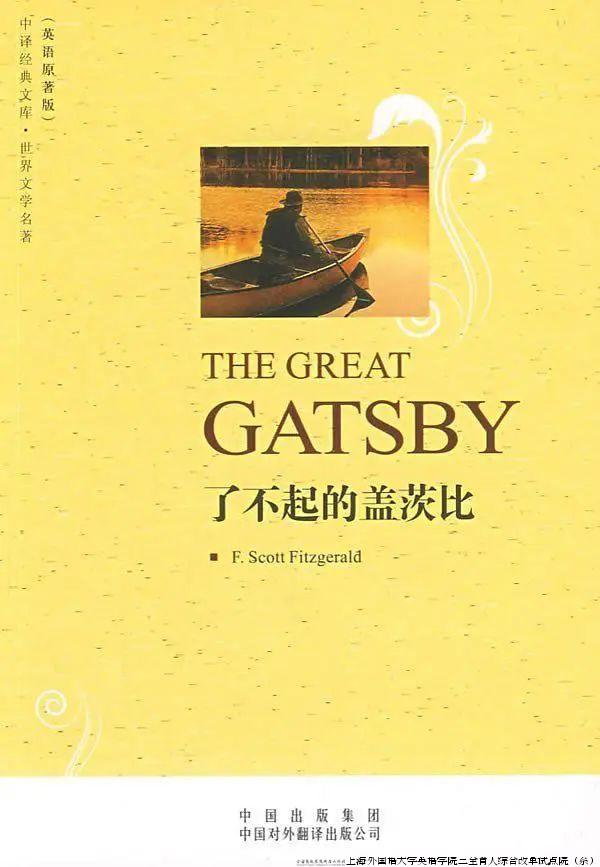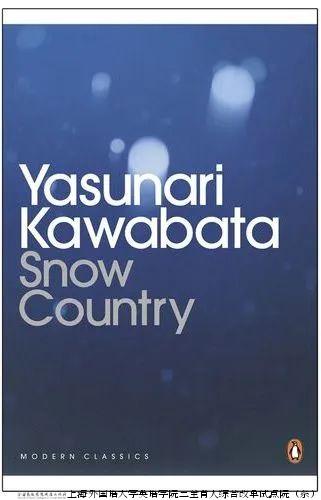作为深化学院师生阅读共同体建设的关键环节,爱阅荐书栏目欢迎英华学子们踊跃投稿,分享对教师推荐或自选优秀读物的阅读感悟。期待通过推介活动,丰富大家的阅读选择,点燃同学们对阅读的热情,同时也促进师生之间更多的交流与分享。
06
╱ 书香致远 ╱
在本期推送中,徐斐然同学将分享她对《了不起的盖茨比》质朴细腻的阅读体会,带领我们领悟这部美国经典在繁荣与虚空之间展现的独特人性景观。此外,让我们与应晓帆同学一同重温Snow Country(《雪国》),感受英文译本中梦幻般的虚无之美,领略日文原作晶莹剔透的艺术世界,并探讨平凡中蕴藏的深刻内涵。
经典重温
荐书学生:徐斐然
指导老师:李 欣
阅读书目:《了不起的盖茨比》斯科特·菲茨杰拉德

文/徐斐然
《了不起的盖茨比》,创作于19世纪20年代,是美国文学史上的一部经典著作。其先后多次被改编为影视作品,搬上银幕。我个人先是被2013版电影的配乐“Young and Beautiful”(《风华正茂》)所吸引,再看了1974版电影,最后才找书来看。
内容概括起来很简单,是一个男人为了心爱的女人奋斗拼搏达到事业成功,为令已婚的少年恋人回心转意使出千方百计讨好,终而为她顶罪牺牲的故事。情节有些离奇,又带点凄惨和可笑,读完了却使我陷入长久的缄默的细密的悲痛之中。
由表及里地细细分析,这本书的出彩点首先在于其描写之细腻。它很好地把握了宏大的时代特征,并将其融入细微故事情节之中而不显突兀。盖茨比为了吸引心上人黛西的注意,在家频繁举办舞会,其排场之大、装潢之奢华,在作者细微详尽的描绘中体现得淋漓尽致。坦白说,我原本打算读的是英文原著,但实在是对这种描写无能为力,所以转投中文译本的怀抱。无他,为了达到特定的描写精度,少不得要出现一些特定的、偏僻的、专业的词汇。短短几段描写,美国社会彼时所追求的“成功”境界跃然纸上,在“喧嚣的20年代”,即“爵士年代”中,人人都渴望获得物质层面的成就,过上纸醉金迷的奢靡生活。如果要做横向对比,我会把目光投向《小时代》。同样描写花天酒地的日子,高下立判。这也说明好的描写不仅仅是名词的堆叠,还要注意整体的布局搭配,才能描绘出场景,进而构造出特定世界观。
更进一步来看,这本书的出彩点在对比。强烈的对比增加故事的戏剧性、可读性,让纯洁的灵魂得到升华,让荒诞的走向更显荒诞。盖茨比为了阶级攀升的目标可谓不择手段,但他对爱情的忠诚和执着也令人惊叹。即使相隔八年,他也坚信,破镜可以重圆,即使相隔八年,即使黛西已为人妻、已为人母,他们仍然可以重新走到一起,弥补过去的遗憾,使有情人终成眷顾。而黛西,她天真烂漫,轻率得可爱,或者说娇憨。她最喜欢的颜色是白色,是少女般的纯洁无暇。而在这表象之下,“她的声音里充斥着金钱的味道”,她对物质的崇拜已经深入骨髓。在这一点上,她和她的丈夫汤姆应该称得上是同道中人。物质上的富裕不等同于精神上的慷慨,他们对于自己的情感吝啬至极。正如叙述者尼克所批判的那样:“他们都是冷漠的人。他们把事情搞砸了,就躲回有钱人的世界,变得麻木不仁,躲在能让他们维系下去的东西的背后,让别人去收拾残局。”在盖茨比为了黛西顶罪被枪杀后,他们不曾表露出一分同情,也没有半丝愧疚,只是计划好了自己新居的装修设计和欧洲的旅行计划。还有那些宾客们,在盖茨比的派对上不请自来,车水马龙,彻夜狂欢;在盖茨比的葬礼上,却无人出席。虽有人走茶凉之说,但其情谊之淡薄仍令人心惊。
在金钱本位社会中,难免有人裹挟于物质追求的时代浪潮中,不能清晰地辨明物质对于生活是附加地位而非主导地位。由此,盖茨比始终明确自己的人生目标以一种矢志不渝的充斥浪漫主义色彩的激情对其不断求索,而不被其余事物所蒙蔽,其热情就显示出一种异乎常人的纯粹。也因此在他死亡时,这种美好的幻影突如其来地破碎,使人异化的污浊空气更显肮脏。这是一个悲剧,但不是令人放声大哭的悲剧,而是在低声呜咽中,接受无奈又荒诞的现实。
荐书学生:应晓帆
指导老师:蔡佳颖
阅读书目:Snow Country
作者:Yasunari Kawabata
译者:Edward G.Seidensticker

文/应晓帆(21级翻译一班)千
“The train came out of the long tunnel into the snow country.” As Shimaruma enters snow country, the readers step into Yasunari Kawabata’s world of “beauty and strangeness.” Orphaned at three, this Nobel Prize winner in literature, a luminary of Japanese and world literature, was accompanied by solitariness during his entire life until he gassed himself in 1972.
Despite the life-long loneliness, his inner world features vividness and colourful experiences. With images spiralling out from centres of high-level innovation – say, a sakura blossom drifting upon a whispering breeze, the reflection of a face of a beautiful lady, the moon in the water, or patterns of thousands of cranes - he transcended the boundaries of conventional storytelling and left an indelible mark on the tapestry of literary artistry. His narratives, akin to vivid brushstrokes on an ancient scroll, painted rich portraits of human intricacies amidst nature’s serene orchestra. His pen, guided by an unspoken alliance with Zen philosophy, beckoned readers to a contemplative realm where the mundane was transformed into the extraordinary. From “The Scarlet Gang of Asakusa” and “The Izsu Dancer” in the early period of his career to the fragile elegance of Thousand Cranes and The Old Capital, Kawabata’s tales unfurled like fragile cherry blossoms in full bloom, with their fragrance lingering long after the final page.
Kawabata, however, is more than a Japanese figure, and such a figure of global influence was only made possible by his early exposure to the Western avant-garde literature when majoring in English and, more crucially, his introspection into the culture of his nation from a brand-new modernist perspective. Readers may analyse how Dostoevsky’s writing style, especially his “extreme psychology”, impacted Kawabata’s literary creation and think over how the technique of “stream of consciousness” influenced this new-sensationalist writer since Kawabata had read Joyce’s Ulysses twice. In such a scheme where such a “strange” combination of Western literary views and oriental philosophy carried over to oriental aesthetics, Japanese modernism named one aspect of the history of global modernism, thus reinforcing a sense of literary history as essentially a process of the interaction between the East and the West.
Just as significant is the novella Snow Country, for it allows us to encounter this writer. Kawabata’s words cascade like delicate snowflakes in the ethereal realm of snow country, enchanting readers with a tale of forbidden love and the haunting beauty of a wintry landscape. This masterpiece of Japanese literature, a symphony of melancholy and desire, beckons us to traverse the path less travelled, where the boundary between reality and dreams becomes blurred. Kawabata’s prose paints a portrait of longing and isolation. Through his meticulous descriptions, readers are transported to a world where silence speaks volumes and emotions are whispered in the hushed language of falling snow. The ephemeral beauty of the landscape becomes a mirror, reflecting the complexities of the human heart; with the delicate interplay of light and shadow, Kawabata explores the depths of human desires and the haunting consequences of unfulfilled yearnings. Through Shimamura and Komako, two souls caught in the intricate web of passion and societal constraints, the author delves into themes of loneliness, fleeting connections, and the elusive nature of true intimacy. And the work, at its best, speaks to the high value of the traditional beauty of the Orient. With every stroke, he summoned the essence of simplicity, inviting readers on a profound journey through the labyrinthine chambers of the human soul. His words, imbued with introspection and poetic cadence, danced upon the reader’s mind, stirring contemplation of life’s transience and the profound depths hidden within the ordinary.
So, step into the world of Snow Country, where whispers of snowflakes blend with the sighs of the human soul. Allow yourself to be swept away by the wintry enchantment and discover the profound truths beneath the frozen surface of this timeless masterpiece.
我要评论 (网友评论仅供其表达个人看法,并不表明本站同意其观点或证实其描述)
全部评论 ( 条)